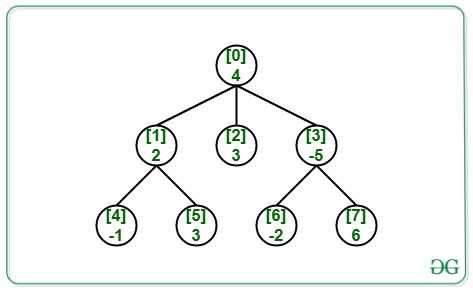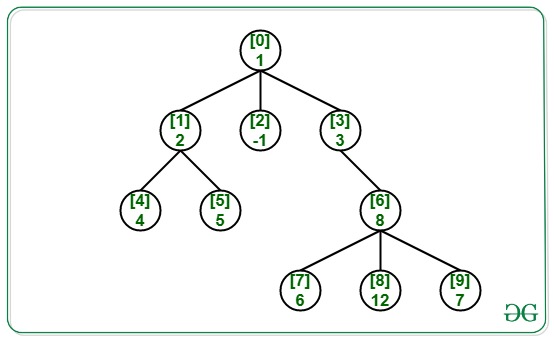给定一棵具有由N个节点组成的正负值且(N – 1)个边的N元树,任务是在其中找到级别总和的最大绝对差。
例子:
Input: N = 8, Edges[][2] = {{0, 1}, {0, 2}, {0, 3}, {1, 4}, {1, 5}, {3, 6}, {6, 7}}, Value[] = {4,2, 3, -5,-1, 3, -2, 6}, Below is the graph:

Output: 6
Explanation:
Sum of all nodes of 0th level is 4.
Sum of all nodes of 1st level is 0.
Sum of all nodes of 2nd level is 6.
Hence, maximum absolute difference of level sum = (6 – 0) = 6.
Input: N = 10, Edges[][2] = {{0, 1}, {0, 2}, {0, 3}, {1, 4}, {1, 5}, {3, 6}, {6, 7}, {6, 8}, {6, 9}}, Value[] = {1, 2, -1, 3, 4, 5, 8, 6, 12, 7}, Below is the graph:

Output: 24
方法:要找到水平总和的最大绝对差,先找到最高水平之和最小级别总和,因为最高水平之和最小级别总和的绝对差值总是给我们最大绝对差值即
Maximum absolute difference = abs(Maximum level sum – Minimum level sum)
步骤如下:
- 在给定的N元树上执行BFS遍历。
- 在进行BFS遍历时,请分别处理不同级别的节点。
- 对于每个要处理的级别,请计算级别中节点的总和,并跟踪最大和最小级别总和。
- 经过上述遍历后,找出最大和最小电平总和的绝对差。
下面是上述方法的实现:
C++
// C++ program for the above approach
#include
using namespace std;
// Function to find the maximum
// absolute difference of level sum
void maxAbsDiffLevelSum(int N, int M,
vector cost,
int Edges[][2])
{
// Create the adjacency list
vector adj[N];
for (int i = 0; i < M; i++) {
int u = Edges[i][0];
int v = Edges[i][1];
adj[u].push_back(v);
}
// Initialize value of maximum
// and minimum level sum
int maxSum = cost[0], minSum = cost[0];
// Do Level order traversal keeping
// track of nodes at every level
queue q;
q.push(0);
while (!q.empty()) {
// Get the size of queue when
// the level order traversal
// for one level finishes
int count = q.size();
int sum = 0;
// Iterate for all the nodes
// in the queue currently
while (count--) {
// Dequeue an node from queue
int temp = q.front();
q.pop();
sum = sum + cost[temp];
// Enqueue the children of
// dequeued node
for (int i = 0;
i < adj[temp].size(); i++) {
q.push(adj[temp][i]);
}
}
// Update the maximum level
// sum value
maxSum = max(sum, maxSum);
// Update the minimum level
// sum value
minSum = min(sum, minSum);
}
// Return the result
cout << abs(maxSum - minSum);
}
// Driver Code
int main()
{
// Number of nodes and edges
int N = 10, M = 9;
// Edges of the N-ary tree
int Edges[][2] = { { 0, 1 }, { 0, 2 },
{ 0, 3 }, { 1, 4 },
{ 1, 5 }, { 3, 6 },
{ 6, 7 }, { 6, 8 },
{ 6, 9 } };
// Given cost
vector cost = { 1, 2, -1, 3, 4,
5, 8, 6, 12, 7 };
// Function Call
maxAbsDiffLevelSum(N, M, cost, Edges);
return 0;
} Java
// Java program for the above approach
import java.util.*;
class GFG{
// Function to find the maximum
// absolute difference of level sum
static void maxAbsDiffLevelSum(int N, int M,
int []cost,
int Edges[][])
{
// Create the adjacency list
@SuppressWarnings("unchecked")
Vector []adj = new Vector[N];
for(int i = 0; i < adj.length; i++)
adj[i] = new Vector();
for(int i = 0; i < M; i++)
{
int u = Edges[i][0];
int v = Edges[i][1];
adj[u].add(v);
}
// Initialize value of maximum
// and minimum level sum
int maxSum = cost[0], minSum = cost[0];
// Do Level order traversal keeping
// track of nodes at every level
Queue q = new LinkedList();
q.add(0);
while (!q.isEmpty())
{
// Get the size of queue when
// the level order traversal
// for one level finishes
int count = q.size();
int sum = 0;
// Iterate for all the nodes
// in the queue currently
while (count-- > 0)
{
// Dequeue an node from queue
int temp = q.peek();
q.remove();
sum = sum + cost[temp];
// Enqueue the children of
// dequeued node
for(int i = 0;
i < adj[temp].size();
i++)
{
q.add(adj[temp].get(i));
}
}
// Update the maximum level
// sum value
maxSum = Math.max(sum, maxSum);
// Update the minimum level
// sum value
minSum = Math.min(sum, minSum);
}
// Return the result
System.out.print(Math.abs(maxSum - minSum));
}
// Driver Code
public static void main(String[] args)
{
// Number of nodes and edges
int N = 10, M = 9;
// Edges of the N-ary tree
int Edges[][] = { { 0, 1 }, { 0, 2 },
{ 0, 3 }, { 1, 4 },
{ 1, 5 }, { 3, 6 },
{ 6, 7 }, { 6, 8 },
{ 6, 9 } };
// Given cost
int []cost = { 1, 2, -1, 3, 4,
5, 8, 6, 12, 7 };
// Function call
maxAbsDiffLevelSum(N, M, cost, Edges);
}
}
// This code is contributed by Amit Katiyar Python3
# Python3 program for the above approach
from collections import deque
# Function to find the maximum
# absolute difference of level sum
def maxAbsDiffLevelSum(N, M, cost, Edges):
# Create the adjacency list
adj = [[] for i in range(N)]
for i in range(M):
u = Edges[i][0]
v = Edges[i][1]
adj[u].append(v)
# Initialize value of maximum
# and minimum level sum
maxSum = cost[0]
minSum = cost[0]
# Do Level order traversal keeping
# track of nodes at every level
q = deque()
q.append(0)
while len(q) > 0:
# Get the size of queue when
# the level order traversal
# for one level finishes
count = len(q)
sum = 0
# Iterate for all the nodes
# in the queue currently
while (count):
# Dequeue an node from queue
temp = q.popleft()
# q.pop()
sum = sum + cost[temp]
# Enqueue the children of
# dequeued node
for i in adj[temp]:
q.append(i)
count -= 1
# Update the maximum level
# sum value
maxSum = max(sum, maxSum)
# Update the minimum level
# sum value
minSum = min(sum, minSum)
# Return the result
print(abs(maxSum - minSum))
# Driver Code
if __name__ == '__main__':
# Number of nodes and edges
N = 10
M = 9
# Edges of the N-ary tree
Edges = [ [ 0, 1 ], [ 0, 2 ],
[ 0, 3 ], [ 1, 4 ],
[ 1, 5 ], [ 3, 6 ],
[ 6, 7 ], [ 6, 8 ],
[ 6, 9 ] ]
# Given cost
cost = [ 1, 2, -1, 3, 4,
5, 8, 6, 12, 7 ]
# Function call
maxAbsDiffLevelSum(N, M, cost, Edges)
# This code is contributed by mohit kumar 29C#
// C# program for
// the above approach
using System;
using System.Collections.Generic;
class GFG{
// Function to find the maximum
// absolute difference of level sum
static void maxAbsDiffLevelSum(int N, int M,
int []cost,
int [,]Edges)
{
// Create the adjacency list
List []adj = new List[N];
for(int i = 0; i < adj.Length; i++)
adj[i] = new List();
for(int i = 0; i < M; i++)
{
int u = Edges[i, 0];
int v = Edges[i, 1];
adj[u].Add(v);
}
// Initialize value of maximum
// and minimum level sum
int maxSum = cost[0], minSum = cost[0];
// Do Level order traversal keeping
// track of nodes at every level
Queue q = new Queue();
q.Enqueue(0);
while (q.Count!=0)
{
// Get the size of queue when
// the level order traversal
// for one level finishes
int count = q.Count;
int sum = 0;
// Iterate for all the nodes
// in the queue currently
while (count-- > 0)
{
// Dequeue an node from queue
int temp = q.Peek();
q.Dequeue();
sum = sum + cost[temp];
// Enqueue the children of
// dequeued node
for(int i = 0; i < adj[temp].Count; i++)
{
q.Enqueue(adj[temp][i]);
}
}
// Update the maximum level
// sum value
maxSum = Math.Max(sum, maxSum);
// Update the minimum level
// sum value
minSum = Math.Min(sum, minSum);
}
// Return the result
Console.Write(Math.Abs(maxSum - minSum));
}
// Driver Code
public static void Main(String[] args)
{
// Number of nodes and edges
int N = 10, M = 9;
// Edges of the N-ary tree
int [,]Edges = {{0, 1}, {0, 2},
{0, 3}, {1, 4},
{1, 5}, {3, 6},
{6, 7}, {6, 8},
{6, 9}};
// Given cost
int []cost = {1, 2, -1, 3, 4,
5, 8, 6, 12, 7};
// Function call
maxAbsDiffLevelSum(N, M, cost, Edges);
}
}
// This code is contributed by 29AjayKumar 24
时间复杂度: O(N)
辅助空间: O(N)